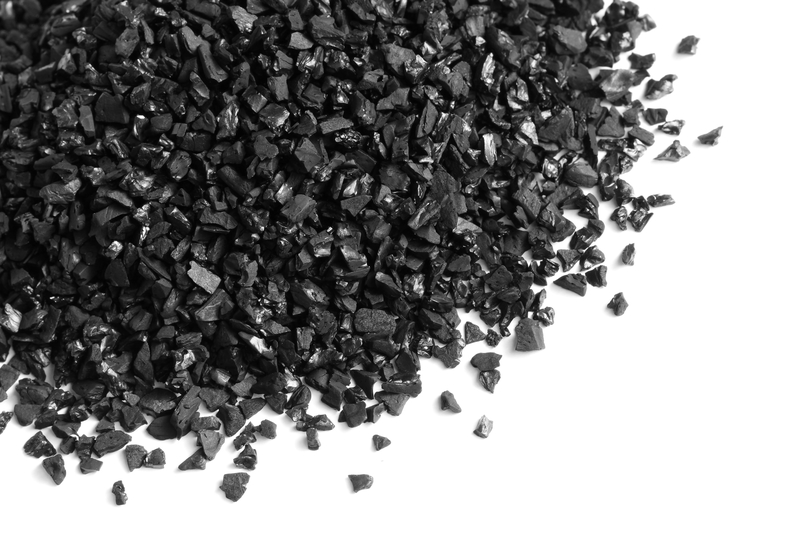The process to make activated carbon requires a few tools and materials, but it's an investment in your personal health. It has a cleansing power that is unlike any other substance. You can make multiple batches in the future to keep your carbon stash supplied. There are also videos below explaining how to make a gas mask and water filtration system by employing activated carbon. You don't need to be a prepper to learn those skills!
How to Make Activated Carbon
Step 1 – Hardwood, coconuts, or just about anything else that is porous and will burn well can be used for this purpose. Make sure the material is as dry as possible.
Step 2 – Put the material in a pot and cover it. The pot should have some ventilation holes in it, however the flow of oxygen should remain limited.
Step 3 – If you have a campfire going, set the pot on the fire. The temperature will have to be hot enough to cause the material within the pot to burn. Your goal is to burn off everything but the carbon. It may take several hours. During that time, you should see smoke and gas escaping from the pot.
Step 4 – Let the charcoal cool, and then rinse it to remove any ash or other debris.
Step 5 – Grind the charcoal into a powder. As you get better at making activated carbon, you can try leaving it in small chunks. Remember that later on, the charcoal will need to be saturated with a chemical that will increase pore size.
If the chunks are too large, you may not achieve this goal, and the resulting activated carbon will not be as efficient or as effective. Make sure the charcoal from Step 5 (this step) is completely dry before mixing it with anything else.
Step 6 – Next, you will either need bleach, calcium chloride, or lemon juice to turn the charcoal into activated carbon.
To make calcium chloride, work outdoors or in some other well ventilated area, and wear goggles, safety gloves that are resistant to acids and other chemicals, and other protective gear. Start off with hydrochloric acid and limestone.
Put the hydrochloric into a glass beaker, but don’t fill more than ¼ of the vessel.
Carefully pour calcium carbonate powder into the hydrochloric acid until the solution stops bubbling. Once the reaction is complete, pour the solution through a strainer so that any lumps are removed. Next, you can heat the solution to remove any excess water. The powder left behind is calcium chloride.
Step 7 – Next, mix the material you choose from step 5, and combine it with 75% water.
Step 8 – Pour enough of the mix from Step 7 into the charcoal so that the charcoal is completely covered.
Step 9 – Let the charcoal sit for 24 hours.
Step 10 – Drain all liquid from the carbon and rinse it to remove any stray chemical left behind.
Step 11 – Remove as much water as possible. The charcoal should be wet without being completely saturated.
Step 12 – Place the charcoal back in the metal pot and let it cook for about 3 hours. If the fire is hot enough to boil water, it will be just the right temperature to finish converting charcoal into activated carbon.
How to Use Carbon for Filtration
Air Filtration
Activated carbon can be used to remove most volatile organic compounds, and many other chemical based contaminants from the air. In fact, if you suffer from chronic medical problems, you might need a pre-fabricated carbon filter attached to a fan or some other source of air flow. Aside from cleaner smelling air, it will ease your health problems.
There are a number of furnace filters available that have activated carbon in them. In most cases, these are little more than a liquid solution of activated carbon added to the filter media.
Make Respirators and Gas Masks Using Activated Carbon
A surgical style activated carbon mask is better than nothing, however you will need a more robust respirator design for gas attacks and other dangerous situations. You can try making them from soda bottles or purchase one made for this purpose, as you see in the video below.
https://www.youtube.com/watch?v=A7SKAPN0zJA
Video first seen on BlackScoutSurvival.
Just remember to practice breathing with these masks, and they can and do restrict air flow. Also make sure you keep the mask clean and change the cartridges on a regular basis.
Using Activated Carbon for Water Filtration
Boiling water will kill off bacteria, however it will actually cause an increase in the concentration of heavy metals, pesticides, and even dangerous drugs that have leached into just about every potable water supply at the surface level. While activated carbon will not remove all heavy metals, it is excellent for removing most other dangerous chemicals and drugs.
At the simplest, just add some activated carbon to a clean sock and pour the water through it. You can also make your own cartridges and add a pump for larger volumes of water.
https://www.youtube.com/watch?v=4N5hdOcsKrg
Video first seen on MakerBoat.
When designing your own system, don’t forget to make it easy to change the cartridge as well as detect when it needs to be changed. Since many water quality issues reflect in changes in pH, you may want to try building a pH sensor into your system so that you know when to change the filter.
Have you made your own activated carbon? What else can it be used for?
Article Source: Survivopedia
